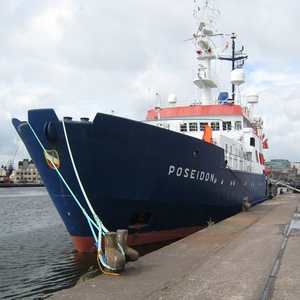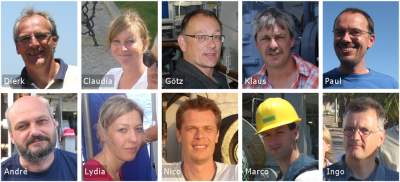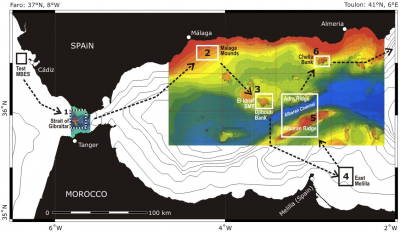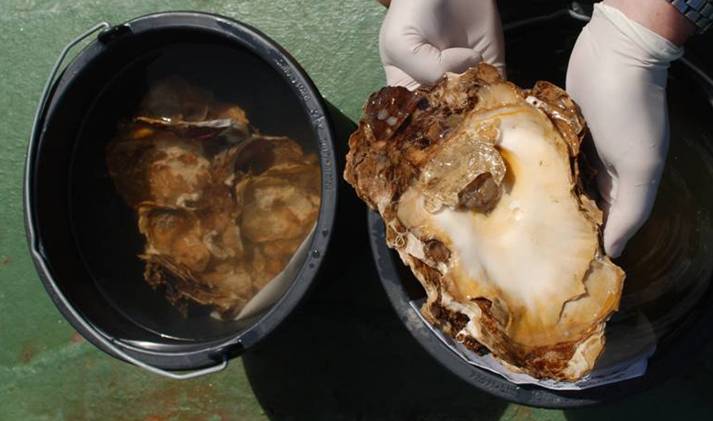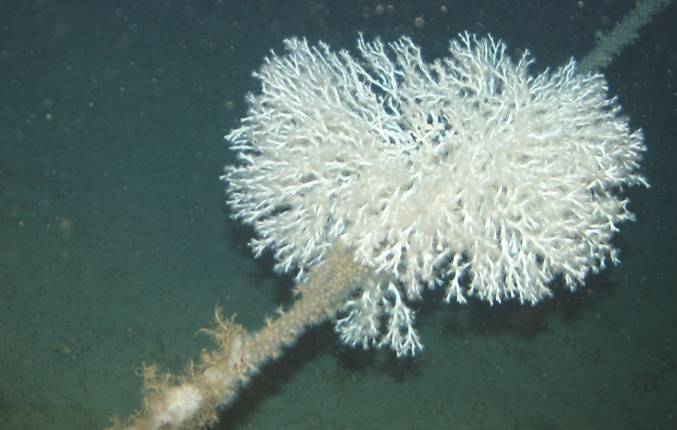Page path:
- Home
- Research
- Expeditions
- 2009
- RV Poseidon P385
RV Poseidon P385
The expedition contributed to the HERMIONE project (Hotspot Ecosystem Research and Man’s Impact on European Seas), an integrated project funded within the 7th FRP of the EU.
Participants
- Dierk Hebbeln (Chief Scientist), MARUM
- Claudia Wienberg (Co-Chief Scientist), MARUM
- Nico Nowald (ROV pilot), MARUM
- Götz Ruhland (ROV pilot), MARUM
- Paul Wintersteller (MBES), MARUM
- Klaus Dehning (Technician), MARUM
- Marco Klann (Technician), MARUM
- André Freiwald (Marine Biology), GZN
- Lydia Beuck (Marine Biology), GZN
- Ingo Klaucke (MBES), IFM-Geomar
Organised by

|
Phone: |
|
|
Fax: |
+49 421 218-9865650 |
|
Email: |
|
|
Room: |
MARUM II, 3180 |
|
Phone: |
|
|
Email: |
|
|
Room: |
MARUM II, 3270 |
Objectives
RV Poseidon cruise P385 was organised by MARUM in co-operation with GZN (University of Erlangen). Targets of the cruise were "potential" cold-water coral (CWC) sites in the Alboran Sea comprising seamounts (El Idrissi Bank, Chella Bank) as well as "mound" cluster (Malaga Mounds, Melilla Mounds) that have been supposed to be "coral mounds".
The cruise specifically focused on the distribution, faunal composition and vitality of cold-water coral ecosystems under present-day as well as under glacial conditions and on the forcing factors driving the observed distribution patterns. Based on a similar strategy including (1) an initial hydro-acoustic characterisation of the selected structures with an MBES, (2) video observations with the ROV Cherokee, (3) sampling of sediments and fauna with box corer and gravity corer, appropriate sediment sampling sites having been selected based on site-survey and visual information resulting from the video observations.
The cruise specifically focused on the distribution, faunal composition and vitality of cold-water coral ecosystems under present-day as well as under glacial conditions and on the forcing factors driving the observed distribution patterns. Based on a similar strategy including (1) an initial hydro-acoustic characterisation of the selected structures with an MBES, (2) video observations with the ROV Cherokee, (3) sampling of sediments and fauna with box corer and gravity corer, appropriate sediment sampling sites having been selected based on site-survey and visual information resulting from the video observations.
New discovery of live cold-water corals & deep-sea oysters
During 11 dives with the Bremen ROV Cherokee extended video surveys across various seabed structures in the Alboran Sea were conducted. All surveyed sites revealed the existence of fossil cold-water corals. On El Idrissi Bank (535 m water depth), even an extended area with massive fossil Dendrophyllia framework was observed. The corals there seemed to have an in situ position, which is quite surprisingly as Dendrophyllia reefs were never observed before. Moreover, live colonies of the cold-water coral species Madrepora oculata, Lophelia pertusa, Dendrophyllia cornigera as well as various solitary corals are far more abundant in the Alboran Sea compared to the Gulf of Cádiz, which constitutes rather a "coral graveyard". Another sensational finding was the occurrence of living deep-sea oysters (Neopycnodonte zibrowii) that colonise steep cliffs at the southern and eastern flank of El Idrissi Bank (390-490 water depth). This was the first time that live deep-sea oysters were observed and sampled in the Mediterranean Sea. And finally, East of the Spanish enclave Melilla along the Moroccan margin, numerous small-sized coral mounds (Melilla Mounds) exist in water depths between 200 and 300 m. A bathymetric survey conducted north of these mounds revealed the southern extension of a shallow platform (Banc de Provencaux) with three sinusoidal ridges being connected to this platform. As the platform-ridge-assemblage has an ophiuroid-like appearance and ROV dives revealed numerous ophiuroids colonizing coral framework, these ridges were named Brittlestar Ridges I to III.
Cruise Report
Working area
live Neopycnodonte zibrowii
Madrepora oculata



